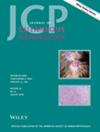Neutrophilic Panniculitis Secondary to BRAF and MEK Inhibitor Therapy to Treat Stage IIIa Cutaneous Melanoma
Abstract
Panniculitides are a group of inflammatory disorders of the subcutaneous fat that have been reported as a rare complication of both a serine threonine kinase BRAF inhibitor monotherapy and BRAF inhibition in combination with a mitogen activated protein kinase (MEK) inhibitor combination therapy used to treat metastatic melanoma. The cutaneous manifestations of BRAF and BRAF/MEK therapies have been well documented, but neutrophilic panniculitis remains a less common complication with fewer case reports. Physician awareness of this complication when following patients on similar targeted therapies can decrease delays in appropriate management. We report a case of one patient who developed neutrophilic panniculitis during treatment with the BRAF/MEK combination of dabrafenib and trametinib. We followed the patient from initial presentation in the emergency department to diagnosis to include pathology findings of the disease. In this case of neutrophilic panniculitis, the patient presented with a history of stage IIIa (pT2a N1a M0) cutaneous melanoma of the right flank and developed classic painful nodules on the lower legs and arms with associated fever within the first 2 weeks after initiating adjuvant melanoma targeted therapy. The biopsies showed a mixed, neutrophilic panniculitis, without overlying epidermal changes. Given the patient's clinical history, the biopsy was consistent with a BRAF inhibitor induced neutrophilic panniculitis. The panniculitis resolved with symptomatic care and the patient was maintained on the antitumor therapies.

 求助内容:
求助内容: 应助结果提醒方式:
应助结果提醒方式:


